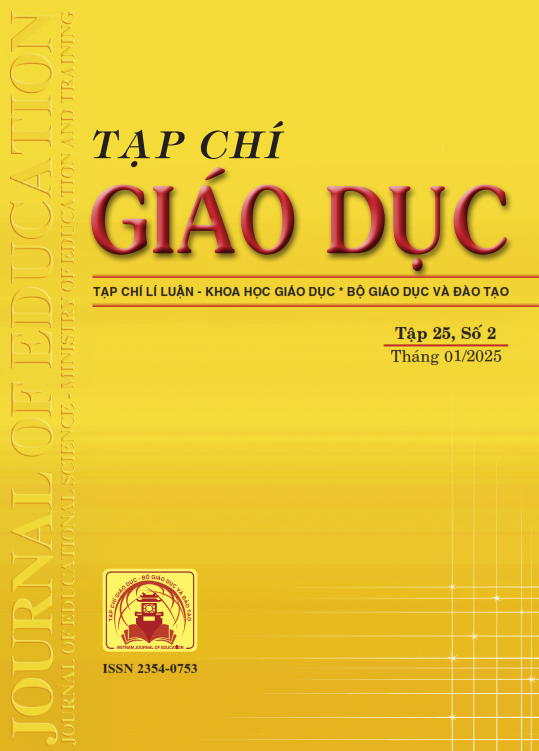Dạy học “Định lí Côsin” (Toán 10) nhằm bồi dưỡng năng lực mô hình hóa toán học cho học sinh
Tóm tắt
According to the General Education Curriculum for Mathematics, one of the five core mathematical competencies that need to be formed and developed for students in teaching Mathematics is the mathematical modeling competency. This study proposes a mathematical modeling process in teaching the “Cosine Theorem” (Math 10), consisting of five steps: determining the data of the initial practical problem; building a mathematical model; solving the mathematical problem; interpreting and determining the rationality of the results in a practical context; accomplishing the solution and answering the initial practical problem. Next, the mathematical modeling process is applied to the experimental teaching of the Cosine Theorem for grade 10 at Nguyen Huu Tho High School, District 4, Ho Chi Minh City. The results of the experimental teaching show that the students actively participated in the mathematical modeling process, discovering the Cosine Theorem through solving practical problems; thereby developing personal capacity, teamwork capacity and mathematical modeling capacity.
Tài liệu tham khảo
Barreto, A. C. (2010). Reference Center for Mathematical Modeling in Teaching. Brazilian Precursors.
Blomhoej, M., & Højgaard, T. (2003). Developing mathematical modelling competence: Conceptual clarification and educational planning. Teaching Mathematics and Its Applications, 22, 123-139.
Bộ GD-ĐT (2018). Chương trình giáo dục phổ thông môn Toán (ban hành kèm theo Thông tư số 32/2018/TT-BGDĐT ngày 26/12/2018 của Bộ trưởng Bộ GD-ĐT).
Đỗ Đức Thái (tổng chủ biên), Nguyễn Sơn Hà, Phạm Sỹ Nam, Vũ Đình Phượng, Nguyễn Thị Kim Sơn, Trần Quang Vinh (2020). Dạy học phát triển năng lực môn Toán trung học phổ thông. NXB Đại học Sư phạm.
Edwards, D., & Hamson, M. (2001). Guide to mathematical modelling. Basingstoke: Palgrave.
Gürel, Z. Ç. (2023). Teaching mathematical modeling in the classroom: Analyzing the scaffolding methods of teachers. Teaching and Teacher Education, 132(7), 104253.
Haines, C., & Crouch, R. (2001). Recognizing constructs within mathematical modelling. Teaching Mathematics and its Applications, 20(3), 129-138.
Henning, H., & Keune, M. (2004). Levels of modelling competencies. New ICMI Study Series, 10, 225-232.
Kaiser, G. (2007). Modelling and modelling competencies in school. In Mathematical Modelling (pp. 110-119).
Kaur, B., & Dindyal, J. (2010). Mathematical Applications and Modeling. World Scientific Publishing, Singapore.
Lê Hồng Quang (2020). Bồi dưỡng năng lực mô hình hóa toán học cho học sinh trung học phổ thông trong dạy học Đại số. Luận án tiến sĩ Khoa học giáo dục, Trường Đại học Sư phạm - Đại học Thái Nguyên.
Lê Thị Hoài Châu, Nguyễn Thị Nhân (2019). Đánh giá năng lực mô hình hóa của học sinh trong dạy học chủ đề “Tìm giá trị lớn nhất, giá trị nhỏ nhất của hàm số” ở lớp 12. Tạp chí Khoa học Trường Đại học Sư phạm Thành phố Hồ Chí Minh, 16(12), 891-906.
Maab, K. (2006). What are modelling competencies? The International Journal on Mathematics Education, 38(2), 113-142.
McAskill, B., Watt, W., Balzarini, E., Bonifacio, L., Carlson, S., Johnson, B., Kennedy, R., & Wardrop, H. (2011). Pre-Calculus 11. McGraw Hill.
Nguyễn Danh Nam (2016). Phương pháp mô hình hóa trong dạy học môn Toán ở trường phổ thông. NXB Đại học Thái Nguyên.
Stillman, G., Brown, J., & Galbraith, P. (2008). Research into the teaching and learning of applications and modelling in Australia. In Research in Mathematics Education in Australasia 2004-2007 (pp. 141-164).
Tải xuống
Đã Xuất bản
Cách trích dẫn
Số
Chuyên mục
Giấy phép

Tác phẩm này được cấp phép theo Ghi nhận tác giả của Creative Commons Giấy phép quốc tế 4.0 .












